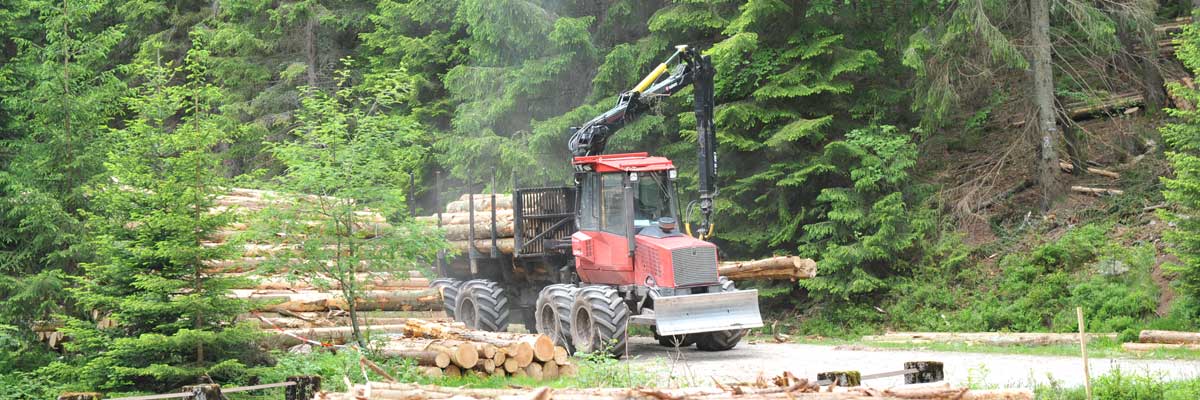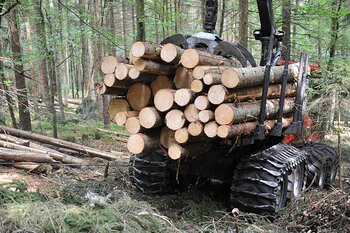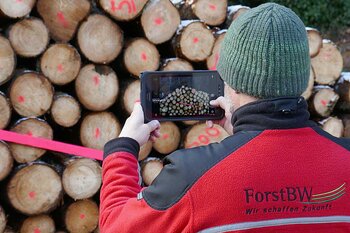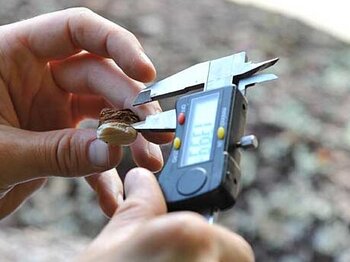Forest utilisation
The Forest Utilisation Department deals with issues of applied research arising from the process chain from the standing tree to the finished product. Of all the different topics of this department, the raw material wood itself is often the main focus of interest. As a renewable natural product, we must give wood a higher status in society and in everyday life. In many areas, its potential for use and development has not yet been exhausted. The aim of the research conducted by the Forest Utilisation Department is to develop procedures for the effective and targeted provision and evaluation of the resource raw timber for efficient material and energy use.
Areas of work
Timber harvesting and logistics
The subjects of our research are the development of timber harvesting methods and the establishment of the relevant quality standards. Our logistics research focuses on optimising the logistics chain as a whole, especially the interfaces of raw wood flow and data exchange. This includes the introduction and optimisation of marking and identification procedures for timber as well as the development of navigation systems for harvesters, forwarders and skidders, and for timber transport.
In the development and adaptation of working methods for timber harvesting and logistics, the focus is on the improved utilisation of wood as a resource through the optimisation of methods and processes. Specifically, our research includes the development, modification, testing and evaluation of timber harvesting methods. Particular attention is paid to technical innovations and intelligent combinations of motor-manual techniques with the use of special forestry machinery. This area of expertise also includes the development, implementation and evaluation of quality standards in timber harvesting, and the investigation of the effects of changes in working methods and market requirements for the timber products provided on various economic, ecological and social parameters. There is a special focus on process optimisation along the logistics chain through the implementation of digital solutions, including marking and identification processes for raw timber and navigation systems for forestry machines.
Kontakt

Frauke Brieger

Dr. Udo Hans Sauter
Measurement and sorting
Technical advances, changed or more differentiated uses and more efficient ways of using the raw material are forcing an ongoing adaptation of the ways in which raw timber is usually measured and sorted. Research in this area includes the development of forward-looking methods for timber measurement in the forest and at the mill, and for the quality grading of raw timber, in close cooperation with the forestry and timber industry.
The measurement and sorting of raw timber increasingly takes place at the factory entrance of the processing industry. The research questions focus on the development of measurement methods and criteria for accurate assignment of raw wood to the appropriate production lines, with a view to improved product assignment and utilisation of the raw material. This includes the further development of practical procedures for the measurement and grading of roundwood in the forest, the review and further development of methods for timber measurement and dimension and quality grading in the mill, and the further development of methodological approaches for detecting internal wood structures using computer tomography. A computer tomograph installed at the FVA for research purposes, combined with a modern 3D measurement system, makes it possible to record information on the inner and outer structure of the roundwood before processing begins. The department is involved at various levels in the current evaluation of wood as a raw material, and in the evolving European and national standardisation for round and sawn timber.
Contact

Dr. Udo Hans Sauter
Dr. Jörg Staudenmaier
Applied wood research
The silvicultural treatment of the stand influences the growth of the trees and thus the development of the timber. As a result, external and internal wood properties and structures can be very different - something which has a decisive influence on the quality of the wood and its suitability for later use. In this field of work, the influence of wood properties and structures on the quality of wood is investigated, and the suitability of wood for specific products and product lines is derived from this.
Applied wood research includes the evaluation of external and internal wood structures and their assessment with a view to processing in the sawmill industry, wood-based material production, the paper and pulp industry, as well as other possible uses including energy use. The research focuses on the practical assessment and evaluation of wood characteristics. The focus of the work is on the great variability of wood properties and use-relevant wood structures. Wood properties such as wood density or wood moisture content and structures such as knots, annual ring width, cracks, resin pockets or reaction wood are assessed with a view to their suitability or limitations for a wide range of uses.
In close cooperation with the processing industry, the department investigates how precisely raw timber assortments should be described, in order to be able to provide the right assortments of raw timber for new products, meeting future requirements for the processed wood.




